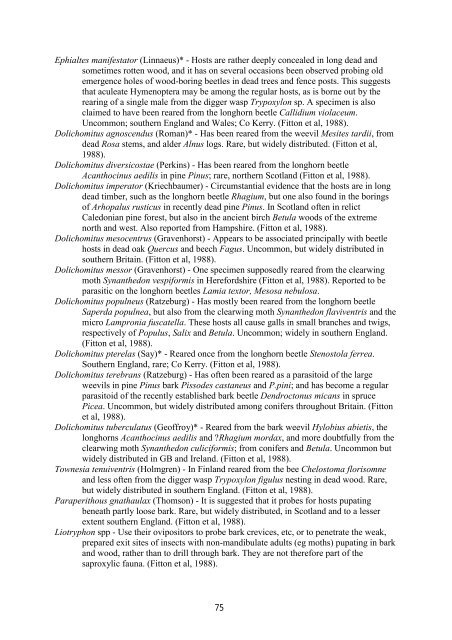Crustacea: Copepoda - Cerambycoidea.com
Crustacea: Copepoda - Cerambycoidea.com
Crustacea: Copepoda - Cerambycoidea.com
Create successful ePaper yourself
Turn your PDF publications into a flip-book with our unique Google optimized e-Paper software.
Ephialtes manifestator (Linnaeus)* - Hosts are rather deeply concealed in long dead and<br />
sometimes rotten wood, and it has on several occasions been observed probing old<br />
emergence holes of wood-boring beetles in dead trees and fence posts. This suggests<br />
that aculeate Hymenoptera may be among the regular hosts, as is borne out by the<br />
rearing of a single male from the digger wasp Trypoxylon sp. A specimen is also<br />
claimed to have been reared from the longhorn beetle Callidium violaceum.<br />
Un<strong>com</strong>mon; southern England and Wales; Co Kerry. (Fitton et al, 1988).<br />
Dolichomitus agnoscendus (Roman)* - Has been reared from the weevil Mesites tardii, from<br />
dead Rosa stems, and alder Alnus logs. Rare, but widely distributed. (Fitton et al,<br />
1988).<br />
Dolichomitus diversicostae (Perkins) - Has been reared from the longhorn beetle<br />
Acanthocinus aedilis in pine Pinus; rare, northern Scotland (Fitton et al, 1988).<br />
Dolichomitus imperator (Kriechbaumer) - Circumstantial evidence that the hosts are in long<br />
dead timber, such as the longhorn beetle Rhagium, but one also found in the borings<br />
of Arhopalus rusticus in recently dead pine Pinus. In Scotland often in relict<br />
Caledonian pine forest, but also in the ancient birch Betula woods of the extreme<br />
north and west. Also reported from Hampshire. (Fitton et al, 1988).<br />
Dolichomitus mesocentrus (Gravenhorst) - Appears to be associated principally with beetle<br />
hosts in dead oak Quercus and beech Fagus. Un<strong>com</strong>mon, but widely distributed in<br />
southern Britain. (Fitton et al, 1988).<br />
Dolichomitus messor (Gravenhorst) - One specimen supposedly reared from the clearwing<br />
moth Synanthedon vespiformis in Herefordshire (Fitton et al, 1988). Reported to be<br />
parasitic on the longhorn beetles Lamia textor, Mesosa nebulosa.<br />
Dolichomitus populneus (Ratzeburg) - Has mostly been reared from the longhorn beetle<br />
Saperda populnea, but also from the clearwing moth Synanthedon flaviventris and the<br />
micro Lampronia fuscatella. These hosts all cause galls in small branches and twigs,<br />
respectively of Populus, Salix and Betula. Un<strong>com</strong>mon; widely in southern England.<br />
(Fitton et al, 1988).<br />
Dolichomitus pterelas (Say)* - Reared once from the longhorn beetle Stenostola ferrea.<br />
Southern England, rare; Co Kerry. (Fitton et al, 1988).<br />
Dolichomitus terebrans (Ratzeburg) - Has often been reared as a parasitoid of the large<br />
weevils in pine Pinus bark Pissodes castaneus and P.pini; and has be<strong>com</strong>e a regular<br />
parasitoid of the recently established bark beetle Dendroctonus micans in spruce<br />
Picea. Un<strong>com</strong>mon, but widely distributed among conifers throughout Britain. (Fitton<br />
et al, 1988).<br />
Dolichomitus tuberculatus (Geoffroy)* - Reared from the bark weevil Hylobius abietis, the<br />
longhorns Acanthocinus aedilis and ?Rhagium mordax, and more doubtfully from the<br />
clearwing moth Synanthedon culiciformis; from conifers and Betula. Un<strong>com</strong>mon but<br />
widely distributed in GB and Ireland. (Fitton et al, 1988).<br />
Townesia tenuiventris (Holmgren) - In Finland reared from the bee Chelostoma florisomne<br />
and less often from the digger wasp Trypoxylon figulus nesting in dead wood. Rare,<br />
but widely distributed in southern England. (Fitton et al, 1988).<br />
Paraperithous gnathaulax (Thomson) - It is suggested that it probes for hosts pupating<br />
beneath partly loose bark. Rare, but widely distributed, in Scotland and to a lesser<br />
extent southern England. (Fitton et al, 1988).<br />
Liotryphon spp - Use their ovipositors to probe bark crevices, etc, or to penetrate the weak,<br />
prepared exit sites of insects with non-mandibulate adults (eg moths) pupating in bark<br />
and wood, rather than to drill through bark. They are not therefore part of the<br />
saproxylic fauna. (Fitton et al, 1988).<br />
75

















